Growth Progression of a Baby Lovebird
This was an adventure to make, but I feel satisfied with the end result! Enjoy!
Supplying all your bird's needs!
We are the owners of an awesome E-Bird store (stuff for all birds of all sizes!) and Lovebird Aviary in Cary, NC. Our birds are quite popular because of their temperaments and socialization. Our dear Angel passed away on July 30th, 2007 and we lost our Evee on September 11, 2013. We have retired from breeding but are advocates of fostering and adoption!
Posted by
Tamara
at
9:50 PM
![]()
Labels: Aria, Babies, Development of a Baby Lovebird, Growth Progression, Harmony, Lovebird, Musical Babies, Piccolo, Video





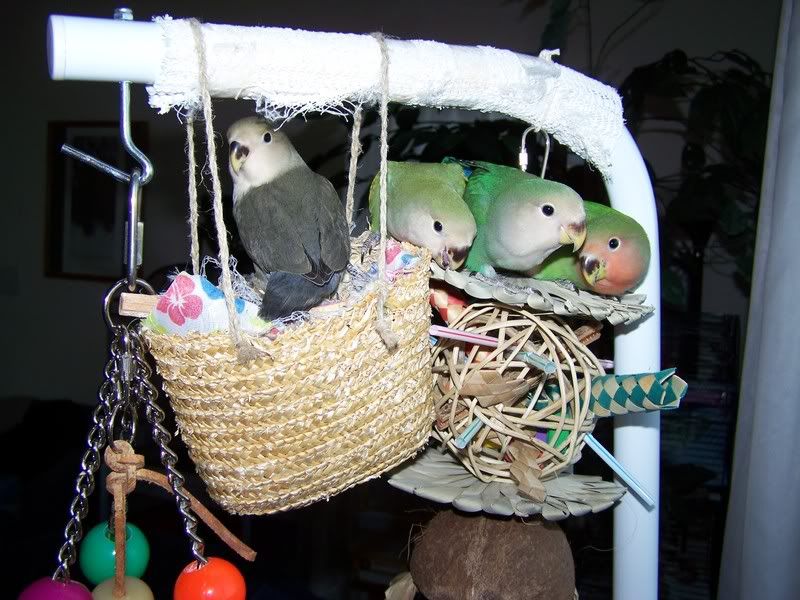

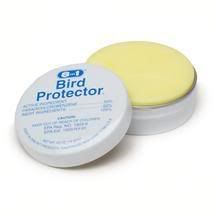

2 weeks old: 5 feedings every 4 hours (8:00am, 12:00pm, 4:00pm, 8:00pm, 12:00am.) Many other breeders only feed 4 times every 4 hours the first week, but we do not want the babies crying for food in the middle of the night. Just like human babies, there are small babies (Pixy!) and there are large babies (her brother Jelly Bean!), so the amount of food is going to vary around 3.5-4.5 cc’s. Tamara and I do not say, “Ok baby, you have had 4 ccs, your full!” No, we fill up the babies until their crops resemble a full balloon or when they simply do not want anymore. Feed the babies all at once; competition is your greatest ally. Well-socialization goal: babies should recognize you, have a wonderful feeding response, and have names.
3 weeks old: 4 feedings every 4 hours (8:00am, 12:00pm, 4:00pm, 8:00pm.) Just fill those crops until they look and feel like a full balloon. At 3.5 weeks old, the babies will start to chew on their bedding. This is the time to introduce “big bird” food. Fresh, chewy Avicakes are the perfect introduction to solid food. Avicakes are highly nutritious unlike seed or millet. After babies are fed baby food, place a very small crumb into their mouths. This works great as a birdie pacifier also. We never feed them mashed-up or soft foods for weaning. Starting them on what they will eat as adults is best. After they are eating “big bird” food, we introduce small foot toys and toys they can shred. Well-socialization goal: babies try “big bird” food, recognize your voice, and step-up on your palm to be fed.
4 weeks old: 3 feedings every 6 hours (8:00am, 2:00pm, 8:00pm.) We never drop their feedings to three until we know they are eating the Avicakes on a regular basis. This is the time when we introduce crushed-up Nutri-Berries and a small pellet like Roudybush Crumble. Depending on the size of the baby, they should be receiving around 6 ccs at this point. Once again, feel the crop and if the babies refuse, do not force them to eat. After we feed them baby food, we place them over the solid food bowl. This is the time we introduce a small dish of water also. Well-socialization goal: babies play with toys, eating adult food on a regular basis, and cry out not only for baby food, but for attention also. Some of the older babies at this point have a natural protective instinct of their siblings and territory, so to dilute this trait we lay down on the floor, cuddle, play with them with their toys, and feed them adult food by hand after each feeding. When they have fallen asleep, we place them back into the brooder.
6 weeks old: 1 feeding per day at 6:00pm or 8:00pm (babies can feed from 7-10 ccs at this point.) If we have a large clutch, 4 or more babies, the prodigies will normally wean during this week. Well-socialization goal: babies are filling up on adult food in the morning, babies want to come out of their weaning cage to fly, cuddle, and most importantly play with toys independently on a playground. Babies should never be on a person all the time when they are outside of their cages. They have to learn independent play and have foraging opportunities.
7 weeks old: A baby should wean at anytime now. If they do not cry for their evening feeding, then do not give it to them. At 7 weeks, we introduce cooked foods, fruits, sprouts, and veggies. The babies will see the adults eating the food and will follow their lead. Many breeders and pet stores separate their babies in individual cages so they will not bond with each other. This is one of the worst things they can do for a baby, especially one that has not weaned yet. Birds need that competition of the food bowl, thus learning to eat on their own and whenever food is presented. Lovebirds that also learn to compete for food will naturally compete for your attention also thus making trust issues virtually nonexistent. Well-socialization goal: the babies step-up from inside their cage, and the babies are excited to see you. Babies need a reason to want to come out of their cages such as a playground. That, plus routine, is the key to a well-socialize parrot and not one that is caged bound and only finds security in the confounds of their bars.
8 weeks old: Weaned. If you decide to clip, never clip a bird before they wean or they might not ever see a reason to get off the baby food. This is nature’s way: stop begging, get off Momma’s fat baby food, and fly! Even though socialization starts as early as two weeks, true socialization actually starts the week babies wean. Too many times we have seen and heard stories of birds that were handfed, but they turned wild. It happens during this week. The babies no longer need you as a source of food, so you need to show them that they still need you for other reasons: love, another source of fun, security, and socialization. During this week, most birds forgot you ever handfed them. All handfeeding does is that it gets a bird use to the presence of humans. So during the week your babies wean, the most important thing any of us can do is to continue a balance of training, positive reinforcement, cuddle time, and independent play. Why is a well-socialized parrot such an important goal? The simple answer is because they will live with people. If a bird is truly trust worthy, affectionate, and socialized, then chances are their humans will see them more than just birds in a cage, but as true family members. Thus, living a full and enrich life in a human household. Well-socialization goal: babies enjoy a great head rub and have first full vet check from an Avian Veterinarian.
~Rodney Money True Love Aviary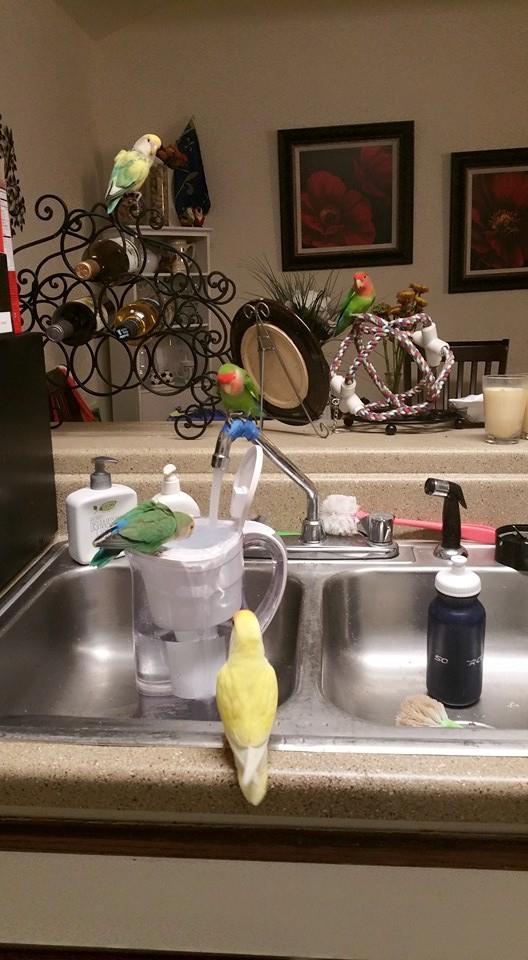

For general questions:
trueloveaviary@trueloveaviary.com
Members of:
 (919) 322-9334 (after 5pm EST, M-F; 10-2pm EST, Sat)
(919) 322-9334 (after 5pm EST, M-F; 10-2pm EST, Sat)





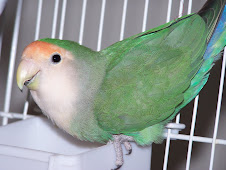


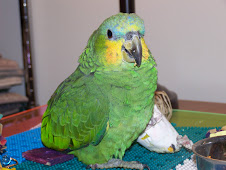




Written by one of the owners of this Aviary, it chronicles the story of how Rodney got his love for parrots, how his life was changed, and asks for help to reconnect with his lost friend, George.

.jpg)
"Lovebirds are just the Jack Russell Terriers of the parrot world." ~Tamara
"They are either in play mode or sleepy cuddly mode. You won't really find them in between. Maybe on a few occasions..." ~Rodney
"I never thought I would be a lovebird person. But man, I wouldn't give them up for anything!" ~Rodney
"Lovebirds are addictive." ~Tamara
"Lovebirds are big birds in little bodies." ~Rodney
"True love is telling your spouse they have bird poop on their shoulder." ~Rodney
"Birds are like potato chips, you can't stop at one."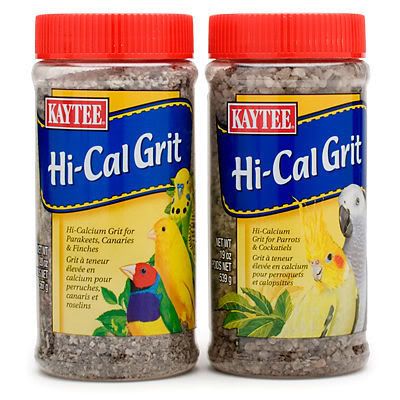
















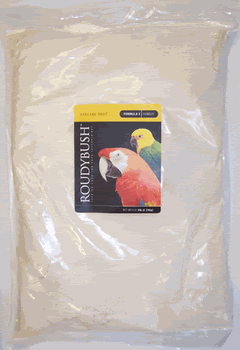
This is the handfeeding formula we use. We used to use Exact Handfeeding formula before we were advised by our vet, Dr. Burkett, that Roudybush formula was way better for babies.
Wow, did we sure notice an immediate change in our babies! We, at first, were puzzled why a few babies in the first clutch we switched over were crying in the middle of the night. We were feeding them the same amount of Roudybush that we had with Exact.
In discussing the change further with Dr. Burkett, we discovered that the babies weren't getting enough food! Why was that? Well, the Exact Handfeeding formula did not digest very well and would stay in the crops for a long time (this can create complications alone). The Roudybush formula was actually digesting and the crop emptying faster!
The babies plumage and health has definitely improved since switching to this formula. We highly recommend it!
Handfeeders: You can get it here



During the weaning process we allow our older birds to demonstrate eating, playing, etc.
All in all, we are continually discovering new things about raising babies and new ways of weaning them. We are kept on our toes with every clutch!

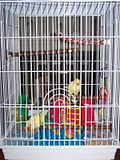 Every thing is slightly lower than in an regular cage.
Every thing is slightly lower than in an regular cage.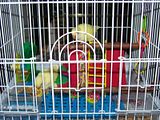
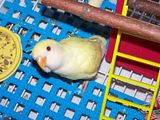 Peek-a-boo! Just coming out of the tent for a peek!
Peek-a-boo! Just coming out of the tent for a peek! Aerial View
Aerial View




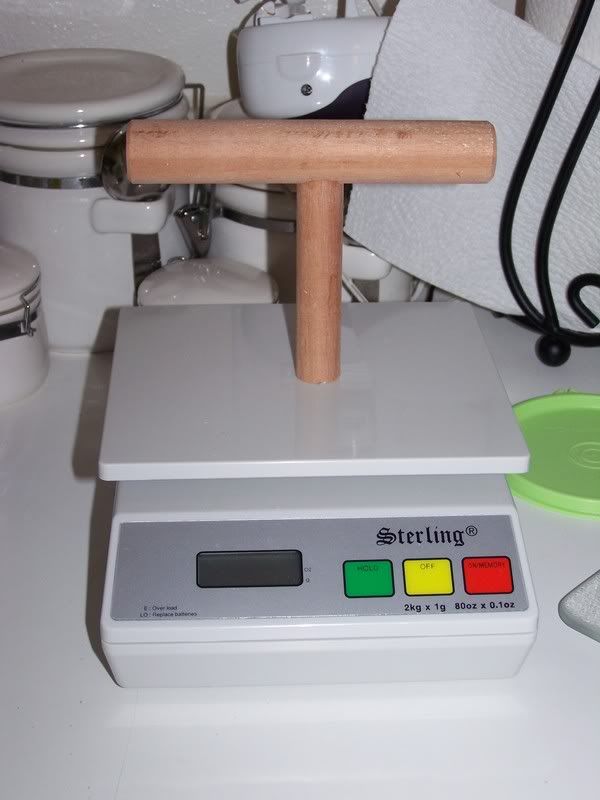 Description:
Description:
This is the best scale we have used. It comes with an AC adapter, a perch securely mounted to a platform, a separate removable platform, and weighs in 1 gram increments.
You can find scales that are priced lower; but you will not find one better. Just think, if you bought a postal scale, what would the bird perch on. You would also need to purchase an adapter. This scale is made for the bird person.
You should weigh your bird regularly and keep a log. This way, you can provide important information to your veterinarian, and you may spot health problems earlier.
This is what our log looks like:
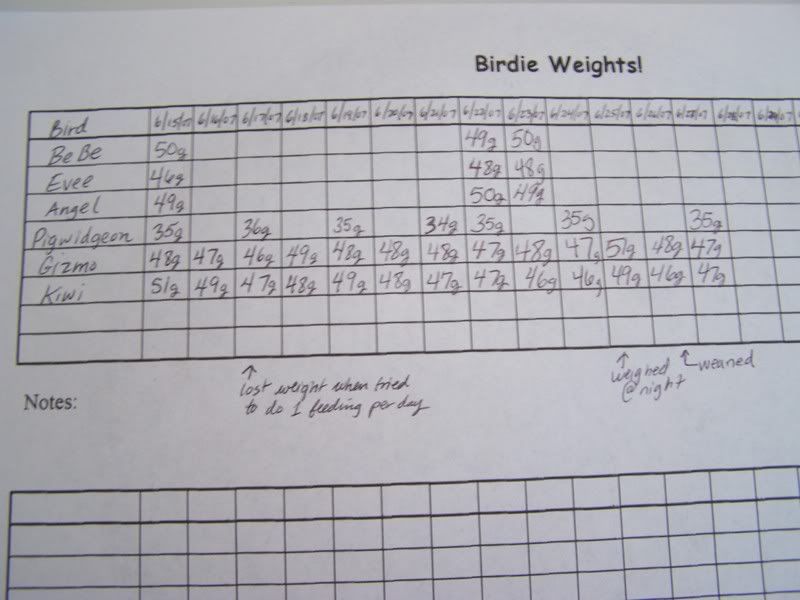
You can get it Here!





Fast-acting gel to stop bleeding; disinfects, too. More convenient and sanitary than powders, and less expensive! New easy-to-use syringe applicator.
We recommend this product over anything else!!! It doesn't sting or clump up like Kwik Stop. Dr. Burkett recommends this product as well! It is safe and effective!
As always, if you have an emergency situation with bleeding, apply pressure and take to your nearest Avian Vet or Emergency Clinic!









 Photo from caiquesarepeopletoo.homestead.com (Trouper and Ripley)
Photo from caiquesarepeopletoo.homestead.com (Trouper and Ripley)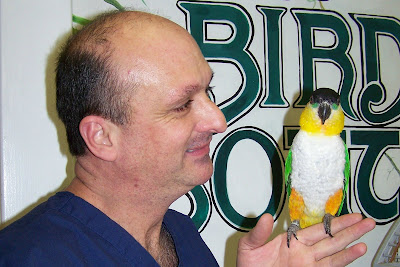
 BeBe decided to hold a special meeting with the entire flock.
BeBe decided to hold a special meeting with the entire flock. Hedwig: "I could let Mia bite my foot and make it bleed all over the place again. They seem to really enjoy patching me up and giving me a bath! Lovebirds like us like to play rough."
Hedwig: "I could let Mia bite my foot and make it bleed all over the place again. They seem to really enjoy patching me up and giving me a bath! Lovebirds like us like to play rough." Dewey: "Hedwig! Are you freakn' kidding me? Nobody wants you bleeding all over our new sunroom again, and I especially don't want you to bleed all over my beautiful feathers. Just thinking about it makes me want to preen. And by the way, how many times do we have to tell you, 'YOU ARE NOT A LOVEBIRD!' You are a budgie!"
Dewey: "Hedwig! Are you freakn' kidding me? Nobody wants you bleeding all over our new sunroom again, and I especially don't want you to bleed all over my beautiful feathers. Just thinking about it makes me want to preen. And by the way, how many times do we have to tell you, 'YOU ARE NOT A LOVEBIRD!' You are a budgie!" Baby Tootsie: "I could let them start hand feeding me again. They just LOVED feeding me night and day for weeks, and weeks, and weeks, and..."
Baby Tootsie: "I could let them start hand feeding me again. They just LOVED feeding me night and day for weeks, and weeks, and weeks, and..." BeBe: "Everyone had great suggestions, but lets just throw our toys, food, and poop more on the new carpet. They seem to really enjoy vacuuming and scrubbing the carpet on their hands and knees since they do it everyday. Everyone agree?"
BeBe: "Everyone had great suggestions, but lets just throw our toys, food, and poop more on the new carpet. They seem to really enjoy vacuuming and scrubbing the carpet on their hands and knees since they do it everyday. Everyone agree?"
I never realized that there was something missing in my life. I was shocked when I realized it was my lovie, BeBe. You see, I knew when I got married that I was marrying a parrot person. I had never owned a parrot in my life! I was under complete misconceptions about parrots in general. Then, we were approached with a decision to accept one of the smallest parrots into our family. Honestly, I had no idea what I was getting into and the love that I would experience for so small a life.
BeBe was a wedding present to my husband and I. He became part of our family in mid-October 2005. He was about 3 months old, but not yet weaned. The story goes that at the home of the breeders, BeBe had actually died. He got too cold and the man of the house saved BeBe by reviving him. BeBe had been almost weaned at that point, but reverted back to his baby stages and wouldn’t get out of them until he was almost 6 months old.
Some people would call BeBe spoiled. I would merit saying, instead, that he is extremely spoiled, well, and extremely loved. We consider him our child, so, in essence, we are normal parents in wanting to give BeBe the best life. People noticed a difference in him right away. Suddenly, we were breaking the bad rap that lovebirds had gotten. The exposure of sweet, loving, playful lovebirds was coming out through our very own baby.
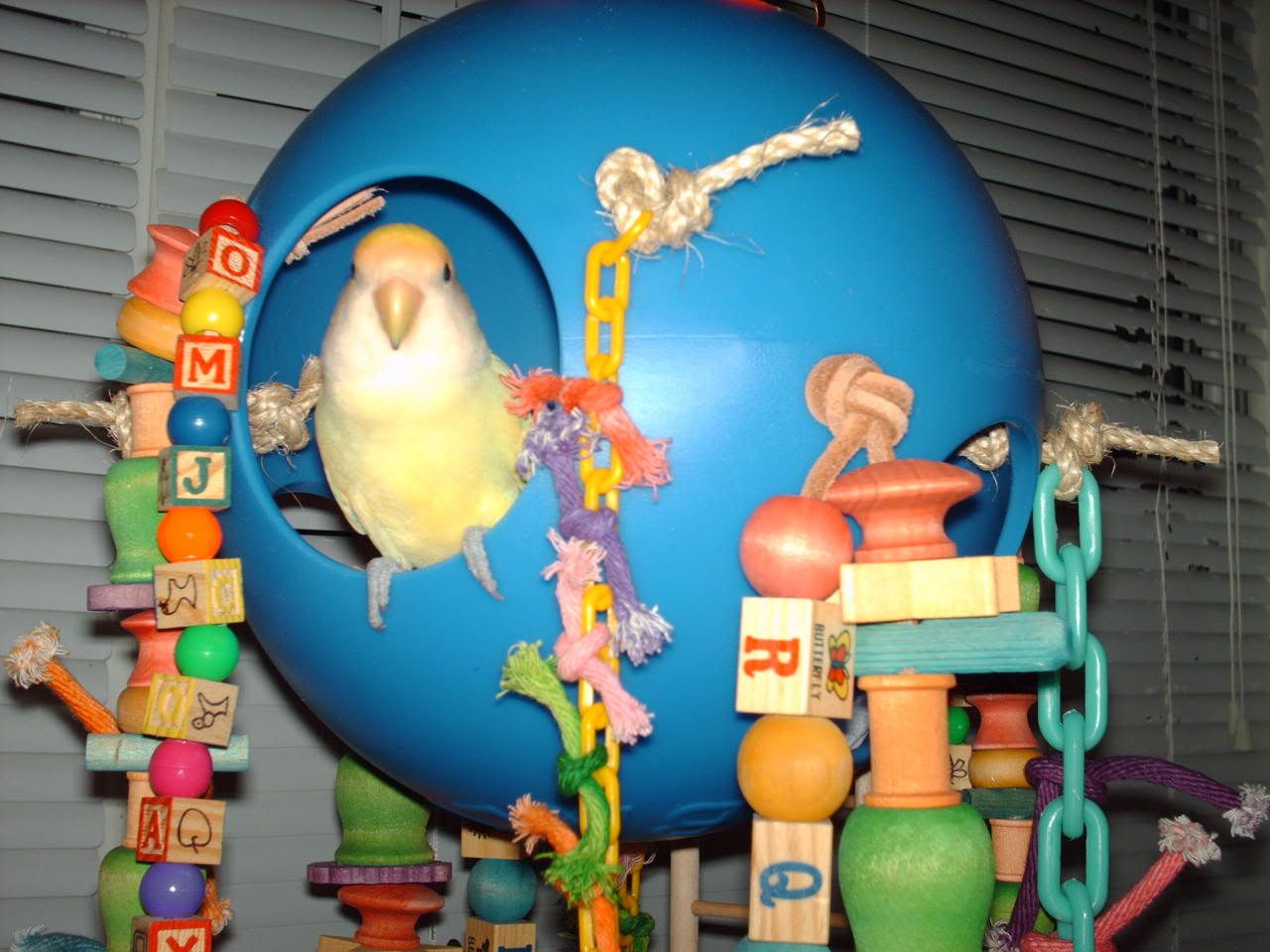
BeBe has always had the most awesome toys. His cage is a plethora of stimulation. However, he remains outside of his cage most of the time. He loves his Penn-Plax playground and Hide-N-Peek Ball especially. Some people might call us extravagant in how we spoil our birds. I just call it a good investment into a long and happy life with them.
People are impressed with BeBe. Though he is small in size, he still stands out in a crowd of other birds. He knows a number of tricks and also how to get into trouble! He prefers to eat off of our plate and go down our shirts. That doesn’t quite work out when we have guests. In one instance, we had a couple over that we were friends with. I was called to rescue BeBe when he went down the shirt of the female guest!
He loves to give kisses. I suspect that if given the chance, he would just kiss me all day. If I ask him if he loves me, he makes a kissing noise at me. Sometimes you will catch him kissing every person he visits when we take him out. Another way he shows his affection for us is by regurgitating on us. Most of the time, it is him going through the motions rather than really anything coming up.
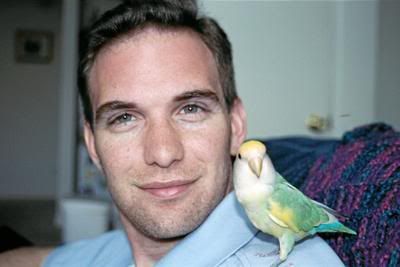
He loves to play “Where’s BeBe?” which is basically a version of Peek-a-boo. He has a great, unique call when he comes out and I say, “There’s BeBe!” It was that call that helped reunite us when he accidentally flew out the door.
After his first molt, we decided to let him keep his flight feathers for a little while. That was until I frightened him when I was putting a box outside my front door. Never in my life, have I been so upset and scared. He took off out and around our apartment building out of my sight. I dashed down the stairs and started calling his name in hysterics. Then I heard the most beautiful sound. He called back to me. Soon, BeBe was back in my arms. I truly didn’t realize how much I loved him until I almost lost him. Needless, to say, I was truly blessed to have him back as many people are not so fortunate.
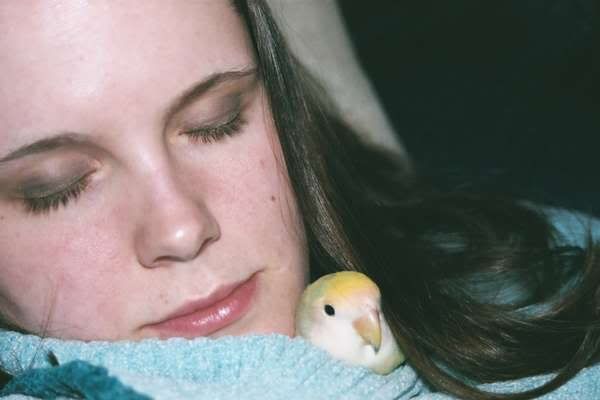
BeBe loves to snuggle. He loves doing his tricks. One of the funniest antics he has is when he imitates a helicopter. He makes the chopping sound and moves around in circles. He also likes to imitate a circus elephant by trying to balance himself on a ball. He loves to play fetch, of course, as we “fetch” and he throws. We’ve been working on one trick for a year now, and I finally think he’s got it down. I ask him if he has fleas, and he pulls his little agile leg over his wing and scratches his head. Of course, his favorite rewards are verbal praise and head rubs!
We decided recently to share our little blessing by raising lovebirds with a similar demeanor. BeBe’s true quality comes out in how he is an example to the new babies. He pays attention to them and cares about them, even so much as to try and regurgitate to them. Many of our new babies have weaned faster by watching BeBe and his actions. He cares so much for other birds that he sometimes risks his own life to visit with birds much bigger than him! We all know, however, that lovebirds are big birds in little bodies anyways.
Most of all, BeBe has taught me how to love deeper and be more patient. We are his flock, his family, his mate. He has given me a new reason to get up early every morning, to play more, and has taught me how to be a better person. I think it is all in learning to love and care for the smallest of deliveries into our lives.
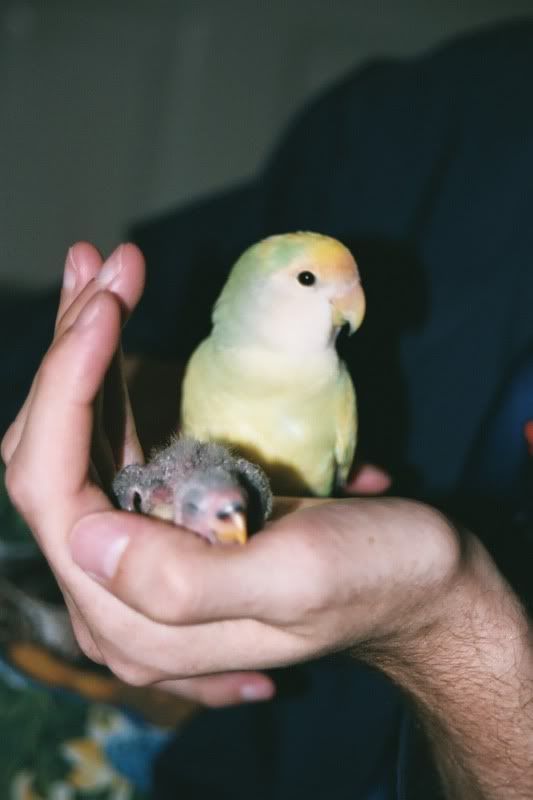
1 comment:
Oh my goodness! Too cute!
Post a Comment